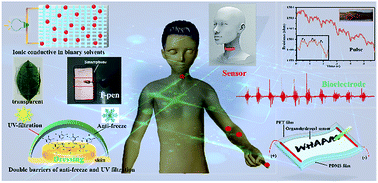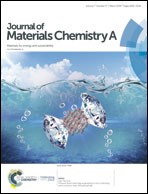An integrated transparent, UV-filtering organohydrogel sensor via molecular-level ion conductive channels†
Abstract
Hydrogel-based strain sensors are promising for skin-like electronics. To satisfy the various requirements of wearable devices used for direct human contact, a hydrogel needs to possess transparent, stretchable, conductive, antifreezing and moisture-retention properties. However, preparation of hydrogels with these properties is challenging. Herein, we innovatively designed and fabricated a transparent, conductive polyvinyl alcohol-tannic acid@talc (PVA-TA@talc) organohydrogel via molecular-level ion conductive channels in ethylene glycol/H2O (EG/H2O), and this organohydrogel integrates excellent conductive, transparent, antifreezing, moisture-retention, toughness, and stretchable properties for the first time. Moreover, this organohydrogel possesses remarkable light filtering capabilities and can effectively filter ultraviolet (UV) light. Interestingly, this organohydrogel can act as a wearable dressing to protect skin from frostbite and ultraviolet radiation. Notably, based on molecular-level ion transport channels, this organohydrogel has great strain sensitivity (gauge factor ≈ 9.17, 0–1.2% strain) that enables recognition of limb movement, pulse, language, and handwriting. The organohydrogel can collect electromyography (EMG) signals as a bioelectrode and be applied to prepare a T-pen for controlling smartphones. In short, this novel organohydrogel has great application prospects for wearable electronics, and the strategy for the organohydrogel constructed via molecular-level ion conductive channels will open a new route for the preparation of multifunctional ionic organohydrogels.



 Please wait while we load your content...
Please wait while we load your content...